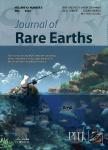Structural and photoluminescence studies of Eu^(3+) doped zinc oxide nanorods prepared by precipitation method
Structural and photoluminescence studies of Eu^(3+) doped zinc oxide nanorods prepared by precipitation method作者机构:Department of Applied PhysicsIndian School of Mines
出 版 物:《Journal of Rare Earths》 (稀土学报(英文版))
年 卷 期:2013年第31卷第1期
页 面:37-43页
核心收录:
学科分类:0709[理学-地质学] 0819[工学-矿业工程] 081704[工学-应用化学] 07[理学] 08[工学] 0817[工学-化学工程与技术] 0708[理学-地球物理学] 0703[理学-化学] 070301[理学-无机化学]
主 题:photoluminescence zinc oxide rare earth europium nanorods nanoflakes
摘 要:Abstract: Trivalent europium doped zinc oxide (ZnO:Eu3+) nanocrystals were synthesized via room temperature chemical co-pre- cipitation and they were systematically characterized by means of X-ray diffraction (XRD), Fourier transform infrared spectroscopy (FTIR) and photoluminescence (PL) spectroscopy. The as-synthesized samples were found to have hexagonal wurtzite coexisted with the intermediate Zn5(OH)sC12·H2O phase, while the single hexagonal phase was facilitated due to the calcinations. The as obtained samples were broadly composed ofnanoflakes while the highly crystalline nanorods were formed due to low temperature annealing of the as-synthesized samples. The crystallite size of the nanoflakes and nanorods (40-90 nm) were extracted from the XRD pattern which was found to be consistent with scanning electron microscopy (SEM) measurements. The photoluminescence (PL) spectra of nanophosphors showed bright red and orange emissions at 618 and 594 nm respectively with efficient broad blue green emis- sion spectrum due to ZnO lattice. Further, a good energy transfer process from ZnO host to Eu3+ was observed in PL emission and excitation spectra of Eu3+ doped ZnO ions. In all, the present nanophosphors were found to have great potentiality for bio-appli- cations.



